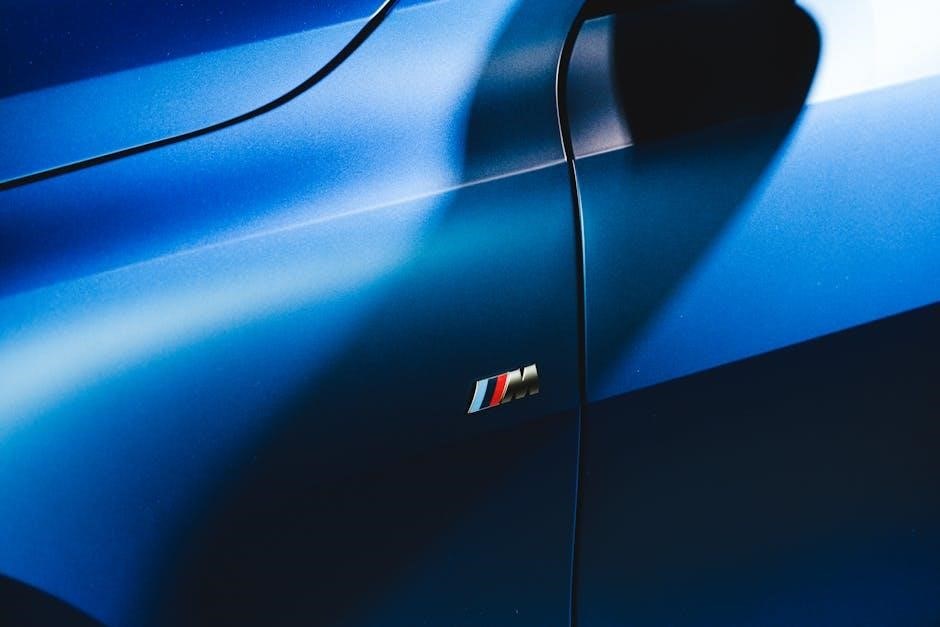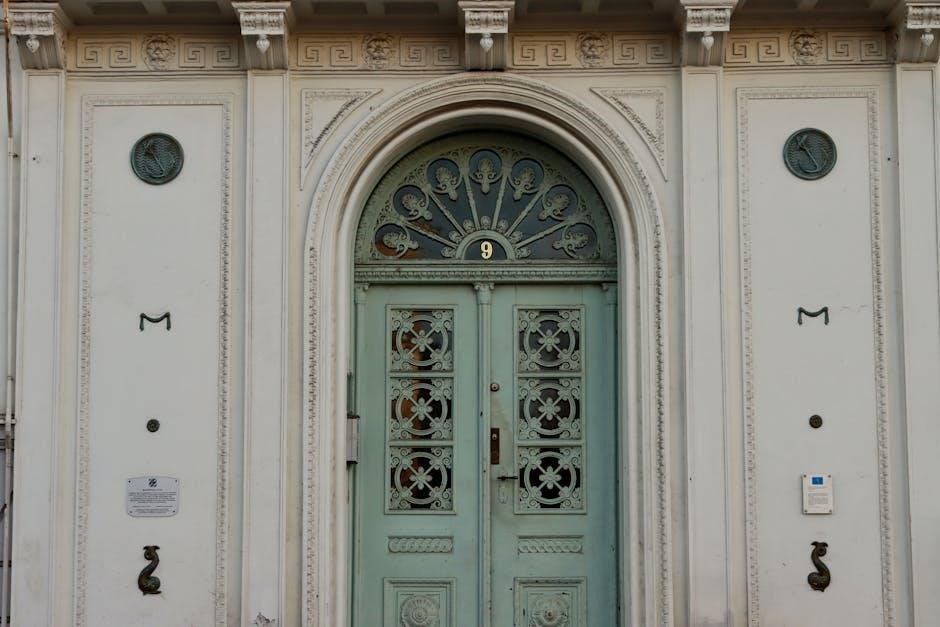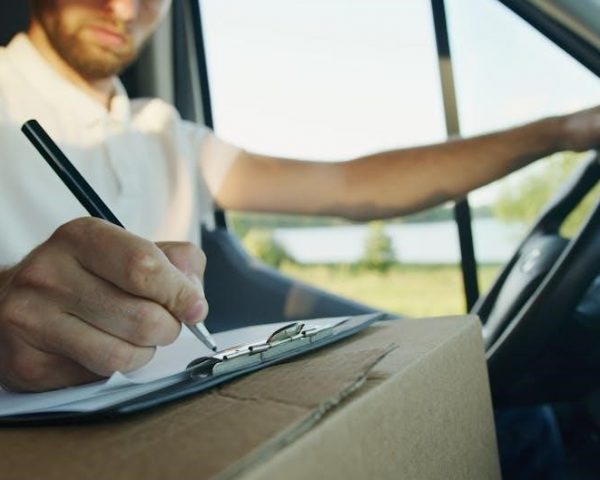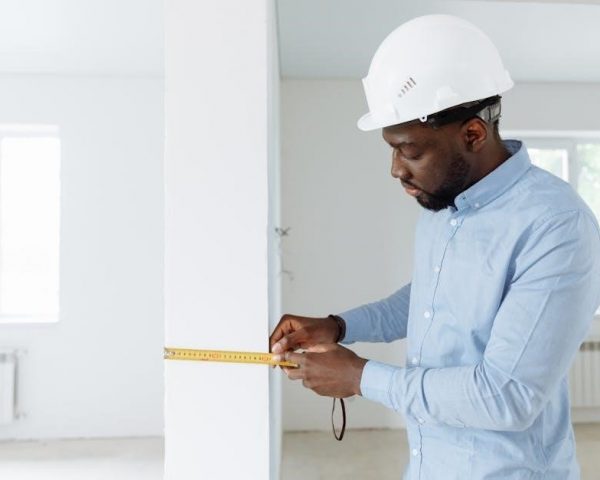Welcome to our guide on the BMW manual fuel door release location. This feature is essential for resolving issues when the electronic system fails to open the fuel door. Knowing where to find the manual release mechanism ensures quick access to refueling, especially in emergencies. Commonly located in the trunk on the right-hand side, this simple mechanism, often marked with a green handle or knob, provides a reliable backup solution for BMW models like the 3 Series, X3, and i3.
1.1 Overview of BMW Fuel Door Mechanism
The BMW fuel door mechanism is designed to provide secure and convenient access to the fuel filler. It integrates seamlessly with the vehicle’s central locking system, ensuring the fuel door locks and unlocks in sync with the car doors. In most BMW models, the fuel door is electronically controlled, opening automatically when the car is unlocked. However, a manual release mechanism is also provided as a backup solution. This mechanism is typically located in the trunk, on the right-hand side, and features a green handle or knob with a fuel pump icon. Familiarity with this system is crucial for resolving issues when the electronic system fails or when the fuel door becomes stubborn. Understanding how the mechanism works ensures drivers can refuel without delays, even in unexpected situations.
1.2 Importance of Knowing the Manual Release Location
Understanding the location of the manual fuel door release is crucial for BMW owners, as it provides a reliable backup solution in case the electronic system fails. Knowing this location ensures quick access to the fuel filler, preventing delays during refueling. It also empowers drivers to address situations where the fuel door becomes stubborn or locked, avoiding the inconvenience of being stranded. Familiarity with the manual release mechanism is especially important in emergencies, such as when the car’s central locking system malfunctions. By being aware of this feature, drivers can maintain control and confidence, even when unexpected issues arise. This knowledge is a key part of understanding and maintaining your BMW’s functionality.

Understanding the Manual Fuel Door Release Mechanism
The manual fuel door release mechanism offers a reliable solution when electronic systems fail, ensuring fuel access through a simple mechanical override located in the trunk.
2.1 How the Fuel Door Locking System Works
The BMW fuel door locking system is integrated with the vehicle’s central locking mechanism. When the car is locked, the fuel door is also secured, preventing unauthorized access. This system ensures that the fuel filler door remains closed and locked until the vehicle is unlocked or the manual override is activated. The locking mechanism is electronically controlled, responding to commands from the key fob or door lock switches. In cases where the electronic system fails, the manual release handle, typically located in the trunk, provides an alternative method to open the fuel door. This dual system enhances security while offering a practical solution for emergencies.
2.2 Location of the Manual Release Handle
The manual release handle for the BMW fuel door is typically located in the trunk compartment. It is commonly found on the right-hand side of the trunk wall, near the rear quarter panel. This handle is usually a small green-colored lever or knob, designed to be easily accessible in case of an emergency. In some models, the handle may be hidden behind a trim panel, requiring the removal of a cover to access it. This strategic placement ensures that drivers can manually release the fuel door even when the electronic locking system fails. The handle’s location is consistent across various BMW models, making it a reliable feature for quick access when needed.
2.3 Role of the Trunk in Fuel Door Access
The trunk plays a crucial role in accessing the manual fuel door release mechanism in BMW vehicles. By design, the trunk compartment houses the manual release handle, ensuring it remains protected yet accessible. Unlocking the trunk manually often triggers the fuel door to unlock simultaneously, providing a straightforward solution when the electronic system malfunctions. In some cases, accessing the manual release requires removing a trim panel within the trunk, highlighting its integral role in the emergency release process. This design ensures that drivers can reliably access the fuel door even when faced with technical issues, underscoring BMW’s focus on functionality and driver convenience. The trunk’s role is essential for maintaining ease of access in critical situations.

Step-by-Step Guide to Manually Releasing the Fuel Door
This section provides a clear, step-by-step process to manually release the BMW fuel door, ensuring easy access when the electronic mechanism fails.
3.1 Locating the Manual Release Mechanism
The manual release mechanism for the BMW fuel door is typically found in the trunk compartment. For most models, including the 3 Series, X3, and i3, it is located on the right-hand side of the trunk wall. This mechanism is usually marked with a green handle or knob, making it easily identifiable. To access it, you may need to remove a trim cover or panel in the trunk. Once located, pulling this handle will manually release the fuel door latch, allowing you to open the fuel filler door. This feature is designed to provide a reliable backup solution when the electronic release fails. Always ensure the vehicle is unlocked before attempting to use the manual release mechanism.

3.2 Pulling the Green Handle or Knob
Once you’ve located the manual release mechanism, you’ll find a green handle or knob attached to it. This is the key to opening the fuel door manually. Gently pull the green handle or knob toward you with a firm but steady motion. You should hear a slight clicking sound as the latch disengages, signaling that the fuel filler door is now unlocked. After pulling the handle, move to the fuel door and pull it open as you normally would. Ensure the vehicle is fully unlocked before attempting this step, as the central locking system may interfere with the manual release. This simple action provides immediate access to the fuel filler door when electronic systems fail.
3.3 Opening the Fuel Filler Door
After pulling the green handle or knob, you’ll hear a slight clicking sound indicating the fuel filler door latch has disengaged. Now, proceed to the fuel filler door, located on the side of your BMW. Grip the door firmly and swing it open. The door is designed to open smoothly once the manual release mechanism has been activated. If the door feels stubborn, a gentle tug should suffice to overcome any residual resistance. Once open, you’ll have clear access to the fuel cap. Always ensure the door is properly aligned and closed after refueling to maintain the vehicle’s security and appearance. This step completes the manual release process, allowing you to refuel your BMW effortlessly.

Model-Specific Information
Across BMW models like the 3 Series, X3, and i3, the manual fuel door release is reliably found on the trunk’s right side, ensuring easy emergency access.
4.1 BMW 3 Series Fuel Door Release Location
In the BMW 3 Series, the manual fuel door release mechanism is located in the trunk on the right-hand side. To access it, remove the side panel cover in the luggage compartment. You will find a green handle or knob with a fuel pump icon. Pulling this handle disengages the locking mechanism, allowing the fuel filler door to open. This feature is particularly useful in emergencies when the electronic release fails. Ensure the vehicle is unlocked before attempting the manual release, as the fuel door lock is tied to the central locking system. This method provides a reliable and quick solution for accessing the fuel cap when needed.
4.2 BMW X3 Fuel Door Release Location
In the BMW X3, the manual fuel door release mechanism is conveniently located in the trunk on the right-hand side. To access it, remove the trim panel on the trunk wall. You will find a green handle or knob with a fuel pump icon. Pulling this handle disengages the locking mechanism, allowing the fuel filler door to open. This feature is particularly useful in emergencies when the electronic release fails. Ensure the vehicle is unlocked before attempting the manual release, as the fuel door lock is tied to the central locking system. This method provides a reliable and quick solution for accessing the fuel cap when needed.
4.3 BMW i3 Fuel Door Release Location
In the BMW i3, the manual fuel door release mechanism is designed for convenience and emergencies. Located in the trunk, on the right-hand side, this feature provides quick access to the fuel filler door when the electronic system fails. To use it, locate the green handle or knob with the fuel pump icon on the trunk wall. Pulling this handle disengages the locking mechanism, allowing the fuel door to open. This process is straightforward and ensures you can refuel even when the electronic release is unresponsive. The BMW i3’s manual release is a reliable backup solution, making it an essential feature to familiarize yourself with for unexpected situations.
Emergency Release Procedures
In emergencies, the BMW fuel door can be manually released by locating the green handle in the trunk or using the trunk release mechanism to access the fuel filler door.
5.1 What to Do If the Fuel Door is Stubborn or Locked
If the fuel door is stubborn or locked, start by ensuring the vehicle is unlocked, as the fuel door lock is tied to the central locking system. If the electronic release fails, locate the manual release mechanism in the trunk. Pull the green handle or knob on the right-hand side of the trunk wall to manually release the fuel door. If the trunk release mechanism is also unresponsive, check the door locks and ensure the vehicle is unlocked. Avoid forcing the door open, as this could cause damage. If the issue persists, consult a professional mechanic or refer to your BMW manual for further guidance.
5.2 Using the Trunk Release Mechanism
The trunk release mechanism is a key component in accessing the manual fuel door release. If the fuel door is stubborn or locked, unlocking the trunk manually can often resolve the issue. Locate the trunk release handle, typically found on the driver’s side floor or in the glove compartment. Pulling this handle will disengage the trunk lock, allowing access to the manual release mechanism inside. Once the trunk is open, you can pull the green handle or knob on the right-hand side of the trunk wall to release the fuel door. This method ensures quick and safe access to the fuel filler door without causing damage.
5.3 Manual Override Techniques
Manual override techniques provide a reliable solution when the fuel door refuses to open electronically. Locate the green handle or knob on the trunk wall, typically on the same side as the fuel door. Pull this handle firmly to release the fuel door mechanism. For older BMW models, some may require accessing a lever under the rear seat or near the spare tire. Ensure the vehicle is unlocked to avoid resistance. After releasing, check the alignment of the fuel door to prevent misalignment when closing. This method is straightforward and prevents damage, making it a preferred emergency solution for BMW owners. Always refer to your specific model’s manual for precise instructions if needed.
Troubleshooting Common Issues
Common issues with the fuel door include failure to open due to locked doors or faulty central locking systems. Always check if the vehicle is fully unlocked and ensure no obstructions block the mechanism. If the door remains stubborn, verify the manual release handle is functioning properly and consult your BMW manual for model-specific solutions.

6.1 Why the Fuel Door Might Not Open
The fuel door may fail to open due to several reasons. First, it could be locked electronically, requiring the vehicle to be unlocked first. Second, issues with the central locking system or a faulty door lock actuator might prevent the door from opening. Additionally, mechanical problems, such as a broken or jammed release mechanism, can render the fuel door inoperable. In some cases, debris or obstructions around the door or its hinge may block proper movement. Electrical faults, such as a bad fuse or switch, can also disable the release mechanism. Understanding these common issues helps in troubleshooting and resolving the problem effectively. Always start by checking the door locks and central locking system before moving on to more complex solutions.
6.2 Checking the Door Locks and Central Locking System
The fuel door may not open if the central locking system is malfunctioning or if the vehicle is locked. Always ensure the car is fully unlocked using the key fob or door key. If the vehicle is locked, the fuel door will remain closed as a security feature. Additionally, check if the door locks are functioning correctly, as a faulty lock actuator or damaged door lock mechanism can prevent the fuel door from opening. If the issue persists, inspect the central locking system for any electrical faults or obstructions. Ensure the vehicle is in the correct state (e.g;, in “Park” for automatic transmissions) before attempting to open the fuel door. If the problem continues, consult a professional technician to diagnose and repair the issue.
6.3 Ensuring the Vehicle is Unlocked

The fuel door may not open if the vehicle is locked, as it is typically connected to the central locking system. Always ensure the car is fully unlocked using the key fob, physical key, or door handle. If the vehicle is locked, the fuel door will remain closed as a security feature. If the fuel door does not open after unlocking, check if the trunk is also unlocked, as some models require the trunk to be open for the fuel door to release. If the issue persists, verify that the vehicle is in the correct state (e.g., in “Park” for automatic transmissions) before attempting to open the fuel door. If the problem continues, consult a professional technician to diagnose and repair the issue.

Additional Tips and Precautions
Always handle the manual release mechanism gently to avoid damage. Ensure the fuel door aligns properly after opening to prevent misalignment issues. Regularly check for debris or obstructions that may hinder smooth operation. Avoid forcing the door open, as this could cause mechanical failure. After refueling, close the fuel door firmly to secure it properly and maintain vehicle safety. By following these tips, you can ensure long-term functionality and reliability of your BMW’s fuel door system.
7.1 Avoiding Forced Opening of the Fuel Door
Forced opening of the BMW fuel door should be avoided at all costs, as it can cause irreversible damage to the locking mechanism or surrounding components. Instead, locate the green pull handle or knob in the trunk, typically on the right-hand side, and use it to manually release the door. This method ensures a safe and controlled opening without risking mechanical failure. If the door is stubborn, check for obstructions or debris that may be hindering its movement. Never use tools or excessive force, as this could lead to costly repairs. Always prioritize the correct manual release procedure to maintain the integrity of your BMW’s fuel door system.
7.2 Ensuring Proper Alignment After Manual Release
After manually releasing the BMW fuel door, it is crucial to ensure proper alignment when closing it to avoid misalignment or damage. Always guide the door carefully back to its original position, ensuring it aligns with the hinge pins and locking mechanism. Misalignment can lead to improper sealing, reduced fuel efficiency, or even damage to the door or surrounding bodywork. If the door does not close smoothly, inspect for obstructions or debris. Proper alignment ensures the door functions correctly and maintains the vehicle’s aesthetic and structural integrity. Avoid slamming the door, as this can disrupt alignment and cause long-term issues with the locking system.
7.3 Securing the Fuel Door After Use
After manually releasing and opening the BMW fuel door, it is essential to secure it properly to maintain vehicle safety and functionality. Always close the fuel door gently, ensuring it aligns correctly with the locking mechanism. Once closed, use the central locking system to lock the vehicle, which will also secure the fuel door. This prevents unauthorized access and potential tampering. Additionally, check the door’s lock indicator to confirm it is properly engaged. Failing to secure the fuel door can lead to issues such as rattling noises, improper sealing, or even accidental opening while driving. Proper securing ensures the door remains tightly closed and functions smoothly for future use.
Familiarizing yourself with the BMW manual fuel door release location ensures convenience and peace of mind. Always check the trunk for the green handle or knob to access the fuel door manually. Proper alignment and securing the door after use are crucial for maintaining functionality. Understanding this mechanism highlights the importance of knowing your vehicle’s mechanics for troubleshooting and emergencies. This knowledge empowers drivers to handle situations confidently, ensuring smooth operation and safety on the road.
8.1 Summary of Key Steps
8.2 Importance of Familiarity with Vehicle Mechanics
Familiarity with your BMW’s mechanics, such as the manual fuel door release, enhances ownership experience and preparedness. Understanding how systems like the central locking and manual overrides function ensures drivers can address issues swiftly. This knowledge prevents frustration and potential damage from forced opening. Regular maintenance and awareness of model-specific features, like the green handle in the trunk, empower owners to handle emergencies confidently. By staying informed, BMW drivers can optimize their vehicle’s performance and longevity, reducing reliance on external assistance; This proactive approach not only saves time but also fosters a deeper connection with the vehicle, making driving safer and more enjoyable.
8.3 Recommended Resources for Further Assistance
For further guidance on the BMW manual fuel door release, Bimmerforums stands out as a premier resource, offering detailed how-to guides and community support. Additionally, YouTube hosts video tutorials specific to models like the 3 Series, X3, and i3, providing visual step-by-step instructions. Official BMW documentation and owner’s manuals are also invaluable, ensuring accurate and model-specific information. For troubleshooting, forums dedicated to specific BMW models can offer tailored advice. Lastly, BMW dealerships and certified service centers provide professional assistance for complex issues. These resources collectively empower owners to resolve fuel door-related problems efficiently and confidently.


